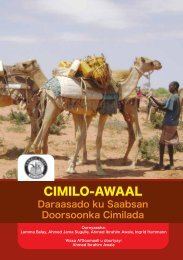Climate Change Vulnerability and Adaptation Preparedness in Kenya
Climate Change Vulnerability and Adaptation Preparedness in Kenya
Climate Change Vulnerability and Adaptation Preparedness in Kenya
Create successful ePaper yourself
Turn your PDF publications into a flip-book with our unique Google optimized e-Paper software.
20<br />
One:<br />
Introduction<br />
The study<br />
Th is study was undertaken as part of the project “<strong>Climate</strong><br />
<strong>Change</strong> <strong>Vulnerability</strong> <strong>and</strong> <strong>Adaptation</strong> <strong>Preparedness</strong><br />
<strong>in</strong> Eastern Africa” of the He<strong>in</strong>rich Böll Foundation<br />
(HBF). Th e project itself is part of the foundation’s<br />
work on climate change <strong>in</strong> Africa. Th e study focused on<br />
<strong>Kenya</strong>’s vulnerability to <strong>and</strong> the state of her adaptation<br />
preparedness for climate change impacts.<br />
Th e aim of the project is to evaluate, by way of case<br />
studies, the level <strong>and</strong> state of preparedness for climate<br />
change adaptation <strong>in</strong> <strong>Kenya</strong> as a way of justify<strong>in</strong>g the need<br />
for new <strong>and</strong> additional fi nancial support for adaptation by<br />
state <strong>and</strong> non-state climate change actors.<br />
The study’s rationale<br />
Despite its <strong>in</strong>signifi cant contribution to global warm<strong>in</strong>g,<br />
Africa is one of the regions most vulnerable to the<br />
adverse impacts of climate change. Th e cont<strong>in</strong>ent’s<br />
high vulnerability stems from many factors that<br />
have cont<strong>in</strong>ually plagued it <strong>in</strong>clud<strong>in</strong>g poverty, weak<br />
<strong>in</strong>stitutions, poor <strong>in</strong>frastructure, lack of <strong>in</strong>formation,<br />
poor access to fi nancial resources, low management<br />
capabilities, armed confl icts, poor governance as well as<br />
lack of or <strong>in</strong>adequate policies to respond to the impacts of<br />
climate change. To add to these, many African countries<br />
are situated where extremes of climate variation such as<br />
drought <strong>and</strong> unpredictable ra<strong>in</strong>fall patt erns, coupled with<br />
fam<strong>in</strong>e <strong>and</strong> related humanitarian disasters, are already<br />
be<strong>in</strong>g experienced. <strong>Climate</strong> change is expected to add<br />
to these extremes, with the poorest communities least<br />
equipped to cope.<br />
He<strong>in</strong>rich Böll Foundation 2010 --<strong>Climate</strong> <strong>Change</strong> <strong>Vulnerability</strong> <strong>and</strong> <strong>Adaptation</strong> <strong>Preparedness</strong> <strong>in</strong> <strong>Kenya</strong>--------------------- -------Introduction to<strong>Climate</strong> <strong>Change</strong> <strong>Vulnerability</strong> <strong>and</strong> <strong>Adaptation</strong> <strong>Preparedness</strong> <strong>in</strong> <strong>Kenya</strong>--<br />
African countries therefore have a genu<strong>in</strong>e cause<br />
for dem<strong>and</strong><strong>in</strong>g new <strong>and</strong> additional adaptation funds.<br />
Further, the African negotiat<strong>in</strong>g bloc has always<br />
dem<strong>and</strong>ed that such funds be anchored on a fi nancial<br />
<strong>in</strong>strument dedicated to adaptation, e.g. the recently<br />
created <strong>Adaptation</strong> Mechanism under the Copenhagen<br />
Accord. While details on how <strong>and</strong> how much funds will<br />
be made available for adaptation fi nance as well as the<br />
arrangements by which these funds will be adm<strong>in</strong>istered<br />
are still emerg<strong>in</strong>g, it is clear that <strong>in</strong> order to make a strong<br />
po<strong>in</strong>t <strong>in</strong> negotiat<strong>in</strong>g for adaptation fi nance, African<br />
countries will have to prove that they are able to utilise<br />
adaptation fund<strong>in</strong>g effi ciently <strong>and</strong> transparently, <strong>and</strong><br />
for the purpose it was <strong>in</strong>tended. Th erefore the need for<br />
adaptation preparedness (climate change awareness,<br />
clear <strong>in</strong>formation on what programmes <strong>and</strong> projects<br />
need fund<strong>in</strong>g, adequate capacity, i.e., well-tra<strong>in</strong>ed climate<br />
change personnel, strong policies <strong>and</strong> <strong>in</strong>stitutions, etc) is<br />
crucial.<br />
African countries are required to report their<br />
vulnerabilities to the impacts of climate change <strong>and</strong><br />
adaptation needs under the United Nations Framework<br />
Convention on <strong>Climate</strong> <strong>Change</strong> (UNFCCC) through<br />
National Communications. Many African countries have<br />
made commendable strides with regard to prepar<strong>in</strong>g<br />
National Communications. <strong>Kenya</strong> for example, submitt ed<br />
to the UNFCCC its fi rst National Communication <strong>in</strong><br />
2002, <strong>and</strong> is <strong>in</strong> the process of prepar<strong>in</strong>g the second.<br />
In addition to the National Communications (NCs),<br />
least developed countries (LDCs) are required to develop<br />
National <strong>Adaptation</strong> Programmes of Action (NAPAs)<br />
detail<strong>in</strong>g their vulnerabilities to climate change impacts<br />
<strong>and</strong> the actions they envisage tak<strong>in</strong>g to ameliorate these<br />
impacts. <strong>Kenya</strong> is not classifi ed as an LDC <strong>and</strong> therefore<br />
does not have a NAPA, (though <strong>in</strong> the yet to be published<br />
National <strong>Climate</strong> <strong>Change</strong> Response Strategy (NCCRS),<br />
a National <strong>Adaptation</strong> Facility (NAF) has been created).<br />
However, there are concerns that adaptation<br />
preparedness <strong>in</strong> many African countries, despite many<br />
of them hav<strong>in</strong>g NAPAs <strong>and</strong> NCs, is still <strong>in</strong>adequate. In<br />
particular, NAPAs are said to be not easily implementable<br />
because they only list priority adaptation needs (<strong>in</strong> the<br />
form of programmes/projects) of a country but do not<br />
take <strong>in</strong>to account the policy framework that governs<br />
adaptation (i.e. ma<strong>in</strong>stream<strong>in</strong>g of adaptation <strong>in</strong>to national<br />
21




